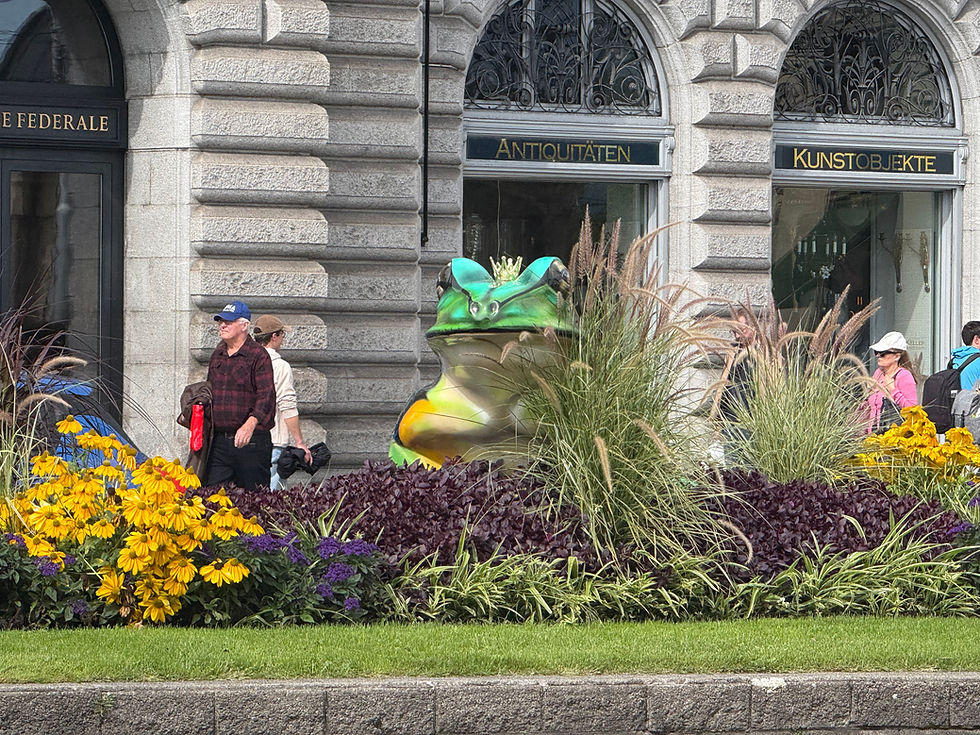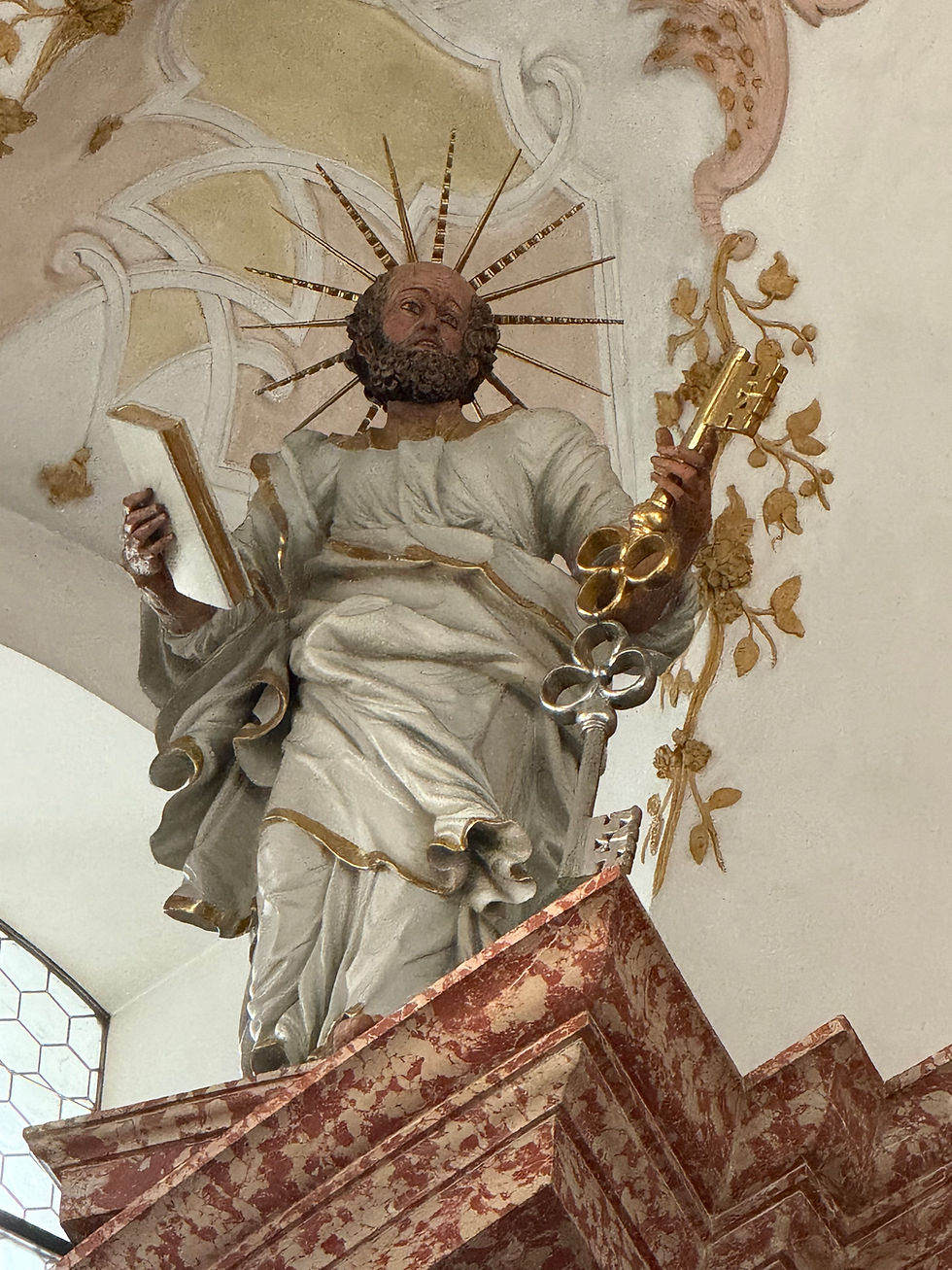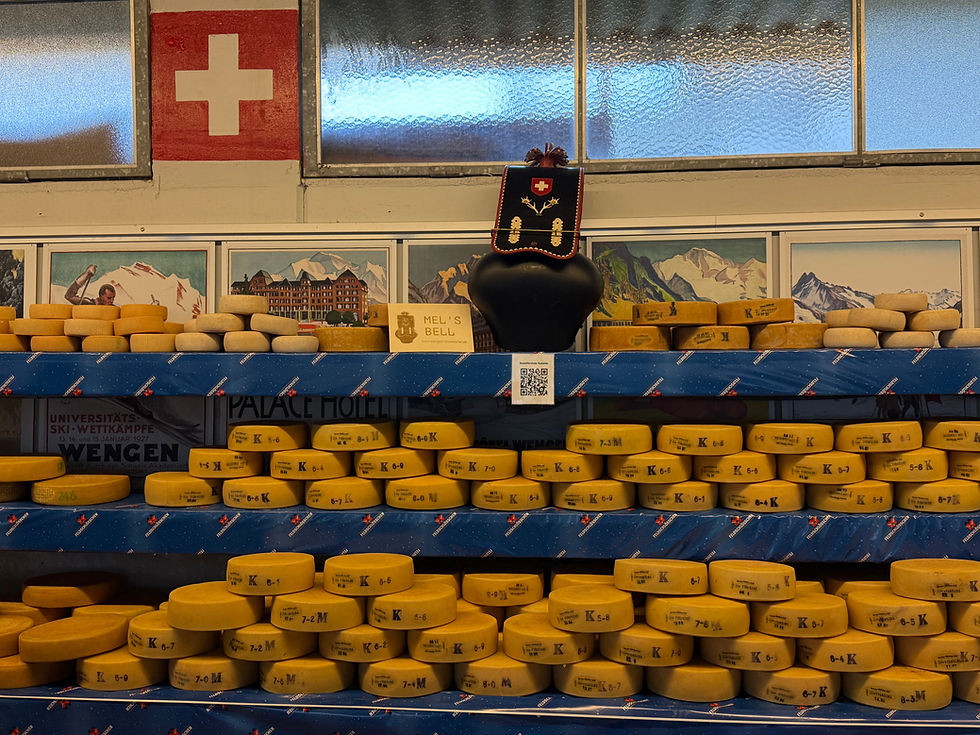Too Many Tourists
- Deborah Kade
- Sep 14
- 9 min read

There were definitely too many tourists in Luzern today. Wait!!!!! We are tourists, too. No, we can't be, as we have been coming here for too many years. Couldn’t believe how crowded Luzern was today. I stopped counting the tour groups after fifteen. Now, I understand why the European are complaining about all the tourists! Even I didn’t think it was fun touring around.
Today we took the roundabout way to Luzern. Took the following trains:
Interlaken West to Thun.
Thun to Konolfingen
Konolfingen to Langnau
Langnau to Luzern
Some of the way we are in the Emmental region.
The Nestle Factory is in Konolfingen.

Emmental Region with the rolling green hills.






The Emmental is is a hilly landscape comprising the basins of the rivers Emme and Ilfis. The region is mostly devoted to farming, particularly dairy farming. The principal settlements are the town of Burgdorf and the village of Langnau.
The original Emmental cheese ( we refer to it as Swiss cheese ) is produced in this region, and the dairy industry still dominates the local economy. Pottery from the region is also prized, and the ceramics of the region have endured practically unchanged since the 17th century. You'll find everything here from the legendary Emmental cheese to ham, to a Gault&Millau menu, an almost unparalleled range on offer and often made from regional products (Ämmitaler Ruschtig).
Tourism has had less impact on the region than on other parts of Switzerland.
This region is famous for its Emmentaler cheese (Swiss cheese in the U.S.) Many happy cows grazing on he hillsides. This area also has many goats and sheep.



They had a bistro on the train from Langnau to Luzern. It is a self serve bistro. You can even get Kambly Bretzeli biscuits. You can purchase a cup of coffee or tea. You can also get a soup packet where you just add water.






Can’t wait to come back to the Kambly factory in a couple weeks to get enough biscuits to fill a large one of our suitcases. I learned a couple weeks ago that you can purchase Kambly’s Bretzeli at Home Goods back in the U.S.
Our first stop in Luzern was at the Old Swiss House. We were looking forward to wienerschnitzel. We were shocked there was no availability until Tuesday. We have only made a reservation once and that was just before Christmas. So….we are coming back to Luzern on Tuesday. Kätherina recognized us. The host went and got Pia so we could say hello. She came over and hugged us.
Well, this is musical festival week in Luzern. Next week it is their film festival week.
We ate lunch at an Italian restaurant next door to the Old Swiss House. I had the chicken schnitzel with orange port wine sauce, rice and vegetables. Michael had the Zūri Geschnetzeltes which is veal strips in a mushroom cream sauce, Rösti, and a dollop of whipped cream to ooze into the sauce.


Four women from Seoul sat next to us on the patio where we were sitting. Michael surprised me by talking to them. He only said a few sentences but I was very proud of him. The women seems quite pleased that he tried.
This is the first time I noticed the Hutmacherei, the hat shop. One of the workers was even measuring a lady’s head. I have a tiny head and my mother always had to try and sew the band some so the hat would fit. I look terrible in hats. My sister on the other hand is quite the opposite. She looks great in hats.




Looks like a bocce ball tournament was happening. Teams measured and measured distances.








So many things to see as we stroll along the lake.









We heard music as we strolled along the lake. We came upon a band in the Old Town. Looked like they wore masks as they walked around the city. We came upon them again as we crossed the street by the train station.










The Chapel Bridge is Luzern's most photographed destination.The Chapel Bridge these days links the Lucerne Theatre on the south bank of the River Reuss with St. Peter’s Chapel on Rathausquai, passing the Water Tower on the way.



The flowers on the Chapel Bridge were made up of begonias, hanging geraniums, petunias, and ivy.








The lift for the bridge was quite interesting to use.
"A major part of the Chapel Bridge caught fire in the night of August 18, 1993. All that could be saved were the two bridgeheads and the Water Tower. The remainder of the bridge was rebuilt in a record eight months, allowing the «new» Chapel Bridge to be reopened on April 14, 1994. Never before has Central Switzerland experienced such an incident as that which befell the emblem of an entire country and moved so many people around the world. When all is said and done, the Chapel Bridge – an incredible 650 years old – served not only in its early days as a means of crossing the river on foot, but also as part of the town’s fortifications. Forming the bridgeheads were the chapel on the right-hand bank and the Freienhof (now gone) on the left. Immediately recognizable when viewed from the air, the Chapel Bridge and Spreuer Bridge appear to bind the town together."




"Just as significant as the bridge itself was the fascinating cycle of paintings which adorned it and lent it the requisite depth of character. The chronicler of the town of Luzern, Renward Cysat (1545–1614), spent years studying the history of both ancient Switzerland and Christendom and formulating a concept for the pictorial decoration. The bridge was to describe how great good fortune had guided the many accomplishments of the Old Confederacy. Since it proved impossible to fund the venture from the public purse, well-to-do citizens were called upon to sponsor one or more of the panels. Cysat finalized his ideas in 1611, whereupon work could begin. The pictures were first restored in 1646. In 1726, the town had to appoint a watchman to keep an eye on the bridge and prevent youths from constantly vandalizing the pictures. Prior to the fire in 1993, 147 of the original 158 panels were still in existence; 110 of them were directly affected by the fire that destroyed the bridge, of which some two-thirds either went up in smoke or suffered severe damage."
The Water Tower
"The defiant yet handsome Water Tower was erected before the Chapel Bridge, sometime around 1290–1300. Octagonal in shape and with sides 4.4–5 meters long, the edifice is rather unique. The tower is 39 meters in circumference and 34.5 meters in height. It has served a variety of purposes during its 700 years. As a lookout post, the comings and goings of boats in the town’s bay could be monitored. It formed part of the town’s lake-facing fortifications alongside the Hof and Chapel Bridges. It was used as an archive on a number of occasions from the 14th century onward. The town’s archives were finally moved out of the tower in 1919. It served as the cantonal treasury and as a place of safety for war plunder. Until the late 18th century, the tower was also used as a prison. Prisoners had to sit on a toggle and be lowered into the dungeon on the end of a rope, re-emerging only after serving their sentence. Located just above the dungeon is the armory, which today contains an extensive display of weaponry courtesy of the Artillery Association.."


Löwendenkmal, the Lion Monument, is located by a pond in a small park near the Lion's Square and it reminds us of the allegory of a dying lion on the 10th anniversary. Swiss Guards fell at the Tuileriensturm in Paris in August of 1792.

"In a rock grotto surrounded by a park lies a fatally wounded, dying lion, which protrudes a piece of a spear from the back. His head and his right front stop rest on the French coat of arms, to the left of him there are some weapons, next to it the Swiss coat of arms. The lion sculpture has been carved out of the rock, some of its parts are executed as relief. Their paws are about twice as large as human heads. The monument measures about ten by six meters.The Latin motto HELVETIORUM FIDEI AC VIRTUTI (The loyalty and bravery of the Swiss) is engraved above the lion. The names of the 26 fallen officers and the 16 rescued or surviving officers are engraved under the lion. An approximate number of each of the soldiers of the Swiss Guard is given: about 760 killed and 350 rescued or surviving soldiers."

"In Latin, so everyone can understand — The title is the message: in praise of the loyalty and bravery of the Swiss Guard. The ‘Helvetii’ in the inscription are the Swiss men who, for some 300 years, were recruited by private military entrepreneurs as mercenary soldiers in the service of the French kings."
"Between the 15th and 18th centuries, more than 500,000 mercenaries served, 60 percent of whom never returned home. In 1792, the lucrative trade collapsed. Only the names of officers are listed in the inscription."
"The Lion Monument correctly cites the number of officers who fell (26), but the number of soldiers killed, at “approximately 760”, is a legend and should be reduced by half. "
"On August 8. 1792, the regiment consisted of roughly 1500 soldiers. Nearly 300 men were charged with protecting barracks, palaces and other posts in Paris; another 300 soldiers were detached to Normandy. Men from just two military units were stationed at the Tuileries Palace. "
"In the early hours of August, 10, 800 to 900 Swiss – a number that includes volunteers who came to defend the palace and several French noblemen who donned Swiss uniforms – spread out to guard some twenty positions where, on high alert, they awaited the final battle. "
"Far from being a spontaneous action, the attack on 10 August had been meticulously planned over several weeks. The Jacobins had come to the conclusion that peaceful calls to depose the king were pointless."
"The Tuileries Palace was not a fortress like the Bastille: the guards had to fight the 35,000 armed revolutionaries face-to-face. At midday, 400 to 450 Swiss began defending the palace, step by step on the large stairway in the courtyard. One man against one hundred revolutionaries. The last Swiss soldiers fought until 4.00 pm. But resistance was futile, and the siege ended with ‹Save yourself, if you can›. "
"As the king’s protectors, the Swiss Guardsmen embodied the power of the crown, and on August 10th, they stood in the place of the king, who had not yet succumbed to the hate of the people. The resistance put up by the Swiss royalists – ‹sold to the Bourbons›, as the revolutionaries said – triggered a mad fury. The massacre lasted into the night and was a measure of the anti-royalists’ bottled-up anger."
"Records in archives and libraries document that 15 of the 39 Swiss officers present in the Tuileries Palace were killed on August 10th while 11 lost their lives in the September Massacres; some 1200 of the roughly 1500 men serving in the Swiss Guard regiment survived. As such, on the 10 of August 1792 and during the September Massacres, between 300 and 350 officers and Swiss guardsmen were killed in Paris."
"Regarding casualties suffered by the revolutionaries, French sources in Paris cite 376 victims dead and injured."
Of course, we visited two of the Catholic Churches. I lit candles and wrote intentions. The Jesuits charge 2 CHF to light a candle while the other one charges only 1CHF.
The Jesuit Church is so plain on the outside but so ornate on the inside.
Jesuit Church
The Jesuit Church is a Roman Catholic church. It is the first large Baroque church built in Switzerland north of the Alps.

The Jesuit order, founded by Ignatius of Loyola in 1534, were active participants in the Counter-Reformation, the Catholic fight against the birth of Protestantism. Protestant reformers such as Zwingli in Zurich and Calvin in Geneva divided the predominantly Catholic Switzerland. In response, the Jesuits were called in to Luzern by the city council in 1573 to establish a college. Ludwig Pfyffer, mayor of Luzern, offered annual financial support to the Jesuits out of his private funds. The Jesuit College of Luzern was established in 1577 in Ritter Palace, a building originally erected in 1557 as a residence for mayor Lux Ritter.










Construction on the associated church began in 1667. By 1673 the shell of the church and the main façade were completed. The church was consecrated in 1677, though the interior was not yet really finished. Several side altars were still missing and even the high altar was only erected four years later, due to financial problems. The onion topped towers were not completed until 1893. The vault was redecorated in the mid-18th century. The original vestments of Brother Klaus, a famous Swiss patron, are stored in the inner chapel.
A wedding couple just exited St. Leodegar. I didn’t even take a picture of the bride. What is wrong with me.? I usually do. Pretty church to be married in. I did take pictures of the flowers, though.




St Leodegar was built in parts from 1633 to 1639 on the foundation of the Roman basilica, begun in 735, which had burnt in 1633. This church was one of the few built north of the Alps during the Thirty Years War and one of the largest art history rich churches of the German late renaissance period.



"In the 8th century there was already an abbey consecrated to Saint Maurice on the current site of the church, which had been donated by Pepin the Short, and was known at the time as the Monastarium Luciaria. By the 12th century the abbey was under the jurisdiction of the Murbach Abbey, whose patron saint was St. Leodegar."






"In 1291 the abbey was sold to the Habsburgs. In 1433 the city of Luzern, now a member of the Eidgenossenschaft, took control of the abbey, and in 1455 it was converted from Benedictine to a “universal order” church."
"The monastery experienced a heyday during the time of the reformation due to Luzern being a prominent city for the Swiss Catholic cantons. The papal nuncio, resident in Luzern, used the church as his cathedral during this time."
In 1874 the parish church of St. Leodegar was founded and with that the church became simultaneously a monastery church and parish church, as it is today."
Check those white feet.



Bought some Pilatus Urdinkel bread to snack on. Loved the bread!!!







Comments